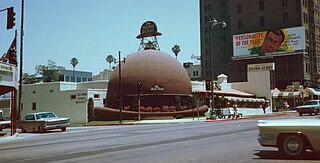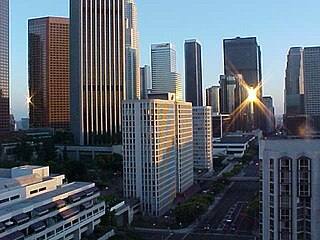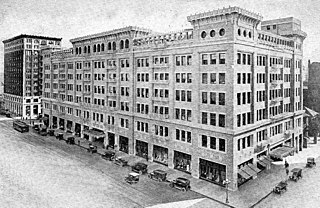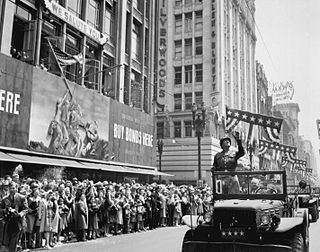Related Research Articles

Hollywood and Vine, the intersection of Hollywood Boulevard and Vine Street in Hollywood, California, became known in the 1920s for its concentration of radio and movie-related businesses. The Hollywood Walk of Fame is centered on the intersection.

Westwood is a commercial and residential neighborhood in the northern central portion of the Westside region of Los Angeles, California. It is the home of the University of California, Los Angeles (UCLA). Bordering the campus on the south is Westwood Village, a major regional district for shopping, dining, movie theaters, and other entertainment.

Hollywood Boulevard is a major east–west street in Los Angeles, California. It runs through the Hollywood, East Hollywood, Little Armenia, Thai Town, and Los Feliz districts. Its western terminus is at Sunset Plaza Drive in the Hollywood Hills and its eastern terminus is at Sunset Boulevard in Los Feliz. Hollywood Boulevard is famous for running through the tourist areas in central Hollywood, including attractions such as the Hollywood Walk of Fame and the Ovation Hollywood shopping and entertainment complex.

Brown Derby was a chain of restaurants in Los Angeles, California. The first and best known was shaped like a derby hat, an iconic image that became synonymous with the Golden Age of Hollywood. It was opened by Wilson Mizner in 1926. The chain was started by Robert H. Cobb and Herbert K. Somborn in the 1920s. The original Brown Derby restaurants had closed or had been converted to other uses by the 1980s, though a Disney-backed Brown Derby national franchising program revived the brand in the 21st century. It is often incorrectly thought that the Brown Derby was a single restaurant, and the Wilshire Boulevard and Hollywood branches are frequently confused.

Miracle Mile is a neighborhood in the city of Los Angeles, California.

The Financial District is the central business district of Los Angeles It is bounded by the Harbor Freeway to the west, First Street to the north, Main and Hill Streets to the east, and Olympic Boulevard and 9th Street to the south. It is south of the Bunker Hill district, west of the Historic Core, north of South Park and east of the Harbor Freeway and Central City West. Like Bunker Hill, the Financial District is home to corporate office skyscrapers, hotels and related services as well as banks, law firms, and real estate companies. However, unlike Bunker Hill which was razed and now consists of buildings constructed since the 1960s, it also contains large buildings from the early 20th century, particularly along Seventh Street, once the city's upscale shopping street; the area also includes the 7th and Flower area at the center of the regional Metro rail system, restaurants, bars, and two urban malls.

J. W. Robinson Co., Robinson's, was a chain of department stores operating in the Southern California and Arizona area, previously with headquarters in Los Angeles, California.
I. Magnin & Company was a San Francisco, California-based high fashion and specialty goods luxury department store. Over the course of its existence, it expanded across the West into Southern California and the adjoining states of Arizona, Oregon, and Washington. In the 1970s, under Federated Department Stores ownership, the chain entered the Chicago, and Washington, D.C., metropolitan areas. Mary Ann Magnin founded the company in 1876 and named the chain after her husband Isaac.

Wilshire Center is a neighborhood in the Wilshire region of Los Angeles, California.

May Company California was an American chain of department stores operating in Southern California and Nevada, with headquarters at its flagship Downtown Los Angeles store until 1983 when it moved them to North Hollywood. It was a subsidiary of May Department Stores and merged with May's other Southern California subsidiary, J. W. Robinson's, in 1993 to form Robinsons-May.
Bond Clothing Stores, Bond Clothes, Bond Clothiers, or Bond Stores, was a men's clothing manufacturing company and retailer. The company catered to the middle-class consumer.

Morgan, Walls & Clements was an architectural firm based in Los Angeles, California and was responsible for many of the city's landmarks, dating back to the late 19th century.

Broadway Hollywood Building is a building in Los Angeles' Hollywood district. The building is situated in the Hollywood Walk of Fame monument area on the southwest corner of the intersection referred to as Hollywood and Vine, marking the intersection of Hollywood Boulevard and Vine Street. It was originally built as the B. H. Dyas Building in 1927. The Broadway Hollywood Building is referred to by both its main address of 6300 Hollywood Boulevard and its side address of 1645 Vine Street.

Coulter's was a department store that originated in Downtown Los Angeles and later moved to the Miracle Mile shopping district in that same city.

Mullen & Bluett was a Los Angeles-based department store specializing in men's clothing.

Myer Siegel was a Los Angeles–based department store, founded by Myer Siegel (1866–1934), specializing in women's clothing.

7th Street is a street in Los Angeles, California running from S. Norton Ave in Mid-Wilshire through Downtown Los Angeles. It goes all the way to the eastern city limits at Indiana Ave., and the border between Boyle Heights, Los Angeles and East Los Angeles.
Milliron's Westchester, later The Broadway-Westchester, was a department store at 8739 S. Sepulveda Blvd., in Westchester, Los Angeles, designed by architect Victor Gruen. Its original design was considered a landmark in exterior architecture of retail stores, although much of the original design is no longer present. The building now houses a Kohl's.

Retail in Southern California dates back to its first dry goods store that Jonathan Temple opened in 1827 on Calle Principal, when Los Angeles was still a Mexican village. After the American conquest, as the pueblo grew into a small town surpassing 4,000 population in 1860, dry goods stores continued to open, including the forerunners of what would be local chains. Larger retailers moved progressively further south to the 1880s-1890s Central Business District, which was later razed to become the Civic Center. Starting in the mid-1890s, major stores moved ever southward, first onto Broadway around 3rd, then starting in 1905 to Broadway between 4th and 9th, then starting in 1915 westward onto West Seventh Street up to Figueroa. For half a century Broadway and Seventh streets together formed one of America's largest and busiest downtown shopping districts.

Swelldom was a large women's clothing store, variously described as a "cloak and suit house" and a "department store", that operated in California from 1906 until the 1970s. It had locations on Broadway in downtown Los Angeles, on Wilshire Boulevard at Camden in Beverly Hills, and near Union Square in San Francisco.
References
- ↑ "Advertisement for C. R. S." Los Angeles Evening Express. October 8, 1922.
- ↑ Longstreth, Richard (1997). City Center to Regional Mall. MIT Press. p. 84-86. ISBN 0262122006.
- ↑ Williams, Gregory Paul (2002). The Story of Hollywood. p. 117, 124, 170, 174, 312. ISBN 9780977629930.